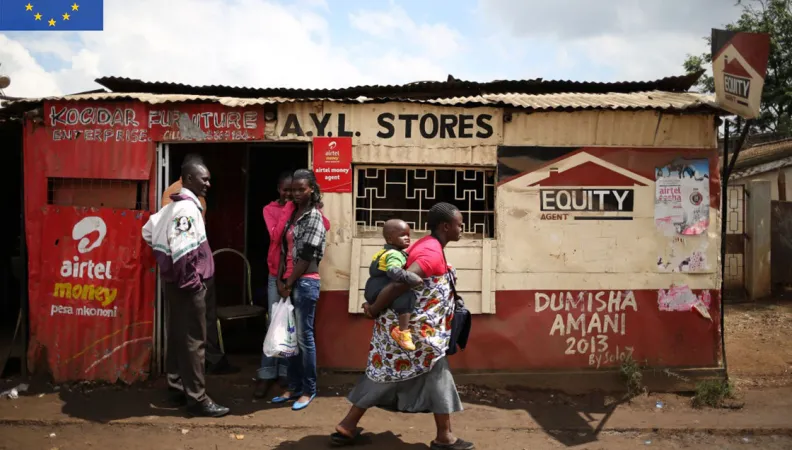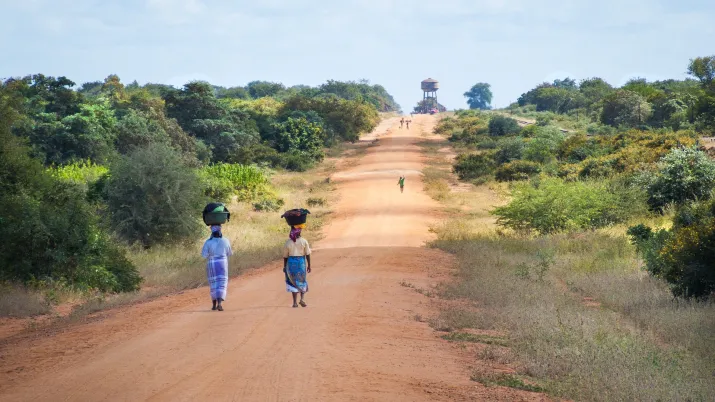Nairobi, Kenya
Nairobi
Kenya
 This research project focused on collective arrangements for access to land and housing in developing cities that are linked with the concept of commons. It studied the implementation of some collective forms of land use in developing cities and their effects, particularly in terms of access to land and housing, reduction of urban inequalities and social inclusion.
This research project focused on collective arrangements for access to land and housing in developing cities that are linked with the concept of commons. It studied the implementation of some collective forms of land use in developing cities and their effects, particularly in terms of access to land and housing, reduction of urban inequalities and social inclusion.
Context
Despite a renewed interest for the notion of “commons” within the academic world, little work has been done about land and housing issues in cities of the Global South.
Yet access to urban land is a major issue for dwellers of these rapidly growing cities and a determining factor for the improvement of their living conditions and for their access to “adequate housing”, according to UN terminology. The mainstream approach to urban land tenure, based on full individual private ownership and the free market, generates speculation and land grabbing, and exclusion of the most precarious households.
The critical dimension of the commons notion opens up innovative ways to produce housing in the Global South, according to plural perspectives that take into consideration the inhabitant’s needs and their agency abilities.
Goal
This research project aimed to highlight the diversity of hybrid, permeable, evolving commons within space and time. These commons aim at getting and securing access rights to land and housing and associated services, which often arise from unexpected opportunities.
The research team looked at innovative ways of holding land: commonly held, with a housing function and in a nonspeculative perspective (when the transfer of land is carried out according to a framework decided beforehand by a community, without any capital benefit).
Method
The methodology was based on case studies in developing cities:
- The first phase of the study (2017-2018) led to three field surveys in Burkina Faso, Kenya and India.
- The second phase (2018-2020) consisted of two additional field surveys (Brazil, Mexico), as well as the follow-up of the work carried out in New Caledonia by students in the framework of the School of Urban Affairs (Master’s Degree « Urban Planning Cycle») of Sciences Po Paris.
The team consisted of:
- An academic with authorization to supervise research (HDR), who directed the study;
- A research engineer, who provided the scientific coordination of the study;
- Local researchers specialising in land and urban issues in survey countries.
The study consisted of five phases: documentary research, field research, data processing, drafting of deliverables, valorisation of research findings.
Results
This research project resulted in the publication of several research papers:
- “Land-based commons for inclusive cities” (available in French): this research paper presents the conclusions of 8 case studies, focused on securing popular habitat through shared ownership of the land.
- “Does Mexico’s social land still bear commons?” (available in French): Mexican common land has undergone major transformations since the 1990s. This research paper presents the study on the outskirts of the metropolitan area of Mexico City led by the students of the Urban Planning Programme of Sciences Po Paris, under the supervision of Jean-François Valette.
- “Regularizing Rio favelas through land pooling?”: the paper sheds light on an original system of collective land regularization in precarious neighborhoods, which puts into practice the notion of “plural property” running through Brazilian law, and which defends the right of the inhabitants to remain in place.
- “User cooperatives in Uruguay: the challenge of housing as common” (available in Spanish)
The final report of the research project on urban land-based commons for housing in the Global South can be downloaded here.
All the publications and events related to the research project are listed on the following website: Communs fonciers pour l’habitat – Quelle contribution à l’inclusion urbaine dans les Suds ? (hypotheses.org)
Lessons learned
"The commons can be understood as a social policy of housing, offering access to housing to the most vulnerable social categories. Moreover, they can provide an alternative path to classical public housing policies which favor individual private property. Indeed, even though these initiatives emerge from dwellers organizations, they might be supported and framed by national governments. Often acknowledged, supported and even presented as standard to be followed, the commons have drawn increased attention recently from dwellers federations, associations, NGOs and international institutions that document their functioning and contribute to the international circulation of these alternative ideas." (Simonneau & Denis, 2021)
Contacts:
- Claire Simonneau, professor and researcher at Université Gustave Eiffel and researcher at the Laboratoire Techniques, territoires et sociétés (LATTS)
- Stéphanie Leyronas, research officier at AFD
 As part of the ECOPRONAT research program, AFD is developing methodologies to assess the environmental sustainability of a territory, to contribute to the structuring of international standards defining “good ecological condition” of an ecosystem. Among these methodologies is the ESGAP (Environmental Sustainability Gap) framework, tested in Vietnam and Kenya.
As part of the ECOPRONAT research program, AFD is developing methodologies to assess the environmental sustainability of a territory, to contribute to the structuring of international standards defining “good ecological condition” of an ecosystem. Among these methodologies is the ESGAP (Environmental Sustainability Gap) framework, tested in Vietnam and Kenya.
Context
Public actors need to monitor the state of the environment in order to assess the effectiveness of their actions, prioritize policies and management measures, and thus objectively establish their contribution to the conservation of natural capital. To do so, they must be able to rely on scientific standards enabling them to define the thresholds from which environmental functions can be considered sustainable.
The ESGAP (Environmental Sustainability Gap) is an innovative tool that assesses the state of a territory’s environmental functions and their level of sustainability. For all critical components of natural capital in the territory concerned (air or water quality, pollution, forest resources, fisheries, etc.), this indicator calculates the difference between their current state and a state that would be sustainable (that is, a state compatible with a sustainable functioning of the processes necessary for the preservation of life, human activities and well-being). This allows the calculation of an “environmental sustainability gap”, which highlights the path that remains to reach the stage of environmental sustainability. This can then serve as a guide for public policy to estimate and preserve the natural state of a given territory.
Within the framework of the ECOPRONAT research program, AFD wishes to develop methodologies for assessing strong sustainability, that is to say adopting demanding criteria concerning the non-substitutability of natural capital by other forms of capital (physical and other) in a territory or country. AFD would also like to promote their use in international settings and contribute to the emerging international standards on the good ecological status of ecosystems.
Goal
This project aimed to test the relevance of the ESGAP framework in developing countries, where not all data on natural capital are always available. In collaboration with the United Nations Environment Programme (UNEP), Paul Ekins' team at University College London (UCL) supported two pilots of this indicator in Vietnam and Kenya.
These pilots were carried out by teams of experts both from national research institutes responsible for monitoring and reporting environmental data: the Kenya National Environmental Management Authority (NEMA) and the Institute of Strategy, Policy on Natural Resources and Environment (ISPONRE) in Vietnam. This work enables better integration of strong environmental sustainability principles into global environmental assessments.
These pilots also sought to better document the challenges of strong environmental sustainability in the series of Measuring Progress reports published by UNEP.
Method
The ESGAP framework is based on a dashboard that provides information on changes in the functional state of 23 components of the environment, focusing on the differences between these changes and the objectives of maintaining or achieving “good ecological status”. These components cover the four main categories of critical and essential environmental functions: the provision of resources, the reprocessing of pollution, biodiversity and human health. The scores of the 23 components are then aggregated to form a synthetic indicator and a dynamic indicator.
Results
The two pilots revealed the general lack of standards for maintaining biodiversity in both countries, as well as significant gaps in environmental regulation, both in Kenya and Vietnam. The lack of historical reference points to measure the good state of the environment is a serious obstacle to the establishment of protection policies and prevents the debate on narratives and development trajectories respectful of the natural heritage.
Moreover, the analysis shows a worrying situation in both Kenya and Vietnam about pollution of natural environments, despite the very limited availability of data on these issues. In Kenya, the results are rather good on natural resources, but many essential and critical contributions of natural capital to human well-being and health are greatly degraded, both for water and air quality, as well as for access to natural amenities. In Vietnam, fish resources, soil erosion, and air and water pollution appear to be the most degraded dimensions.
According to ISPONRE and NEMA, the ESGAP framework has great potential as a tool for communicating the state of a territory and for monitoring public policies in both countries. It offers a framework for broadening the range of topics covered by public policies and proposes a high-quality standard for the establishment of environmental sustainability assessment frameworks.
This research project also supported a flagship UNEP report on the environmental content of the Sustainable Development Goals (SDGs), Measuring Progress: Environment and the SDGs, which incorporates the lessons learned from these two ESGAP pilots. This has shown that, of the 231 SDG monitoring indicators, 77 can be linked to an environmental theme from near or far, but that only 11 of them really describe the state of the environment.
Download the reports:
Lessons learned
Initial feedback indicates that the ESGAP pilots need to be backed up by real capacity-building exercises of the administrations in charge of environmental monitoring and natural capital management, in order to hope to improve environmental diagnostics in the long term.
The concepts of “scientific standards” and “diagnosis of the state of natural capital contributions” also need to be refined, explained and adapted to the available contexts and data: if, ideally, these standards are derived from international frameworks and legitimated at the national level, often alternative indicators must be used to adapt the standards to different contexts.
These lessons complement those from a pilot of the ESGAP indicator, led by AFD and WWF in New Caledonia. Following another ECOPRONAT call for projects, two more ESGAP studies are underway:
- A first study aims to develop indicators for biodiversity and the health of natural ecosystems, as well as an ESGAP methodology in South Africa and Colombia.
- A second study aims to refine socio-economic indicators and study the relationship between the economy and the environment, with Vietnam as a case study.
Contact
-
Oskar LECUYER
Research Officer, Environmental Economist
Discover other research projects
 Legal notice EU (project) Although substantial progress has been made in the fight against poverty, disease, and illiteracy since independence in Kenya, a remaining challenge is linked to inequality. An understanding of inequality causes would help design and implement policies to eliminate it and avert other social problems.
Legal notice EU (project) Although substantial progress has been made in the fight against poverty, disease, and illiteracy since independence in Kenya, a remaining challenge is linked to inequality. An understanding of inequality causes would help design and implement policies to eliminate it and avert other social problems.
Contexte
Over the last twenty years, poverty has declined in Kenya. The poverty rate has fallen from 52% of the population in 1997 to 36% of the population in 2015. However, in 2015 income inequality was still large with more than half of total wealth controlled by the 20% richest of the population. An assessment of inequality causes could help design and implement policies to eliminate it. In particular, policies with well-designed redistributive fiscal components could play a substantial role in reducing income inequality.
This project is part of the first phase of the Research Facility on Inequalities, coordinated by AFD and funded by the European Commission's Directorate-General for International Partnerships over the 2017-2020 period. The first phase of the Facility has led to the conduct of 22 research projects and the publication of around 100 research papers and policy briefs.
Objectif
The proposed research program has two objectives:
- Documentation of inequality and poverty trends in Kenya since independence and diagnosis of their main drivers;
- Assessment of the impact of fiscal policies on inequalities in Kenya.
Méthode
First, the Kenyan National Household Budget Surveys will be used to analyse poverty and inequality trends over a long period of time. These datasets will also be used to assess which factors perpetuate inequalities in the country.
Then, the Commitment to Equity methodology (Lustig and Higgins, 2017) will be used to conduct an in-depth assessment of the impact of fiscal policies on inequalities and poverty. It would enable to analyse who mostly pays taxes and who benefits from transfers and public spending in the country and what fiscal policy instruments have the greatest impact on inequality reduction.
Résultats
The research project will result in two research papers, as well as workshops and policy briefs to disseminate the results to policymakers.
You may find the research paper here:
- Fiscal incidence, inequality and poverty in Kenya: a CEQ assessment
- Inequality trends and diagnostics in Kenya 2020
You may find the policy briefs here:
Contact:
Hélène Ehrhart, Research Officer, AFD
Anda David, Research Officer, AFD
Professor Germano Mwabu, University of Nairobi



